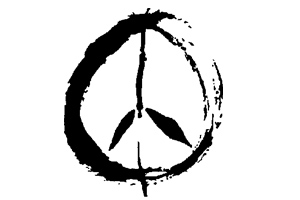Peace & Pacifism
In Israel in 1988, a group of women dressed in black clothes and assembled for weekly vigils in public places, first in Jerusalem and then in other cities, to protest their government’s treatment of Palestinians. It was one year into the intifidah, or uprising, of Palestinians in the occupied territories of the West Bank and Gaza strip. Although the silent protesters, both Israelis and Palestinians, endured heckling and worse, they helped to swell opposition to Israeli government policies. So was born the Women in Black.
This model of peace protest quickly spread around the world. Perhaps the most famous “spin-offs” were in former Yugoslavia, where women protested the fractured country’s descent into war and ethno-chauvinism. The vigils in Serbia began in 1991 to protest the increasingly nationalist government of Slobodan Milosevic, increased in size during the outbreak of wars with Croatia and Bosnia, and eventually fed into the protests that brought down the Milosevic regime in 2000. The Women in Black are peace activists who oppose the rhetoric and policies that spark war. They also protest against the wars that have ensued. They make links between war and nationalism, war and political control, war and male violence, war and human rights. They hold peace workshops and connect with a larger global movement against militarism. They are with us still: in Israel and Serbia, in Belgium, the United Kingdom, Spain, Australia, the United States and elsewhere.
Despite the demise of the Cold War in Europe in the early 1990s and the theory that history had consequently ended, war and the passions that produce war have not melted away.The 1990s and the new millennium have been replete with violent clashes: in former Yugoslavia, former Soviet Union, throughout Africa from Rwanda and Congo to Sudan and Uganda, and most recently in Afghanistan and Iraq. But alongside these wars have sprung new peace movements. The global protests on February 15. 2003 against the preparations for war in Iraq, involving 30 million people in more than 100 countries, constituted the largest peace demonstration in the history of political activism.
While peace movements may dwindle during times of peace, they do not disappear. In the United States, for instance, the peace movement has worked to convert military industries into civilian uses, reduce arms exports, bring down the military budget to create a “peace dividend,” adopt peace curricula in schools, diminish the influence of war toys, advocate for stronger gun control laws, and much more. Stopping particular wars is, in other words, only one part of the peace movement.
One of the key tenets of most peace movements has been non-violence. Drawing from thinkers such as the Buddha, Jesus, Socrates, Gandhi, the Quakers, and Martin Luther King, the nonviolent tradition has deeply influenced many social movements, including the peace movement. For some, nonviolence is an effective tactic, particularly in cases, as Gandhi argued, where the regime requires the consent of the population. For strict pacifists, and there is a lively controversy over whether Gandhi thought of himself as one, war is never an answer to the problems that assail the world and nonviolent ends must always correspond to nonviolent means. Whether for Gandhi or for today’s Women in Black, nonviolence is not a tactic of passive resistance but a courageous act of standing and fighting and even risking death.
Is there no such thing as a just war, even to fight fascism? What happens if moral persuasion and nonviolent means of coercion do not stem the tide of violence? How do we evaluate such alternatives to war as economic sanctions, which in some cases can cause the deaths of so many innocent people? How can peace movements best end wars? How can such movements sustain themselves during periods of relative peace? Which social institutions contribute the most to upholding a culture of militarism – the family, the media, the schools, the entertainment industry? Is peace necessarily boring?
What happens if moral persuasion and nonviolent means of coercion do not stem the tide of violence? How do we evaluate such alternatives to war as economic sanctions, which in some cases can cause the deaths of so many innocent people? How can peace movements best end wars? How can such movements sustain themselves during periods of relative peace? Which social institutions contribute the most to upholding a culture of militarism – the family, the media, the schools, the entertainment industry? Is peace necessarily boring?
On a trip to Provisions, you can read Dr. Seuss’s inimitable critique of the Cold War in the Butter Battle Book, leaf through the provocative and hilarious and depressing posters in Peace Signs: The Anti-War Movement Illustrated, bone up on your peace history online at the Swarthmore College Peace Library website, listen to CD anthology Peace Not War, and watch Robert McNamara squirm under Errol Morris’s questions about his role in the Vietnam War in the documentary The Fog of War.


